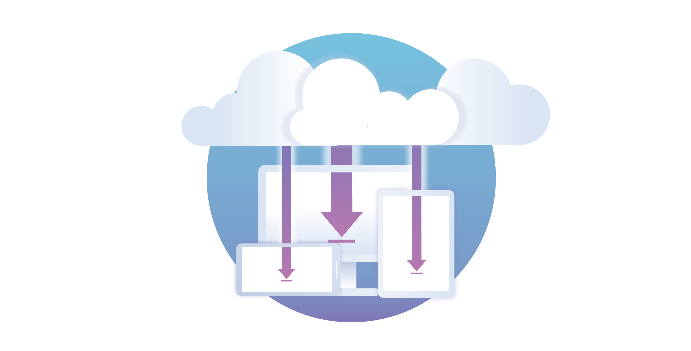Kubernetes testbed
The sFlow-RT real-time analytics platform receives a continuous telemetry stream from sFlow Agents embedded in network devices, hosts and applications and converts the raw measurements into actionable metrics, accessible through open APIs, see Writing Applications.Application development is greatly simplified if you can emulate the infrastructure you want to monitor on your development machine. Docker testbed describes a simple way to develop sFlow based visibility solutions. This article describes how to build a Kubernetes testbed to develop and test configurations before deploying solutions into production.
Docker Desktop provides a convenient way to set up a single node Kubernetes cluster, just select the Enable Kubernetes setting and click on Apply & Restart.
Create the following sflow-rt.yml file:
apiVersion: v1Run the Continue reading
kind: Service
metadata:
name: sflow-rt-sflow
spec:
type: NodePort
selector:
name: sflow-rt
ports:
- protocol: UDP
port: 6343
---
apiVersion: v1
kind: Service
metadata:
name: sflow-rt-rest
spec:
type: LoadBalancer
selector:
name: sflow-rt
ports:
- protocol: TCP
port: 8008
---
apiVersion: apps/v1
kind: Deployment
metadata:
name: sflow-rt
spec:
replicas: 1
selector:
matchLabels:
name: sflow-rt
template:
metadata:
labels:
name: sflow-rt
spec:
containers:
- name: sflow-rt
image: sflow/prometheus:latest
ports:
- name: http
protocol: TCP
containerPort: 8008
- name: sflow
protocol: UDP
containerPort: 6343
Microsoft Warns of Attacks Exploiting Zero-Day Flaws
Microsoft said it’s “aware of limited targeted attacks” using the remote-code execution...
Global Pandemic Strains 5G Supply Chain
Vendors that are projecting stability amid unprecedented calamity and uncertainty face bottlenecks...
Full Stack Journey 040: Learning To Work From Home
A panel of guests share tips, tools, and best practices for working from home in the latest episode of Full Stack Journey. Host Scott Lowe speaks to Puja Abbassi, Lisa Caywood, Simon Crosby, and John Teresick about the challenges and rewards of daily life in the home office.Full Stack Journey 040: Learning To Work From Home
A panel of guests share tips, tools, and best practices for working from home in the latest episode of Full Stack Journey. Host Scott Lowe speaks to Puja Abbassi, Lisa Caywood, Simon Crosby, and John Teresick about the challenges and rewards of daily life in the home office.
The post Full Stack Journey 040: Learning To Work From Home appeared first on Packet Pushers.
The Bandwidth Alliance Charges Forward with New Partners – Alibaba, Zenlayer, and Cherry Servers

We started the Bandwidth Alliance in 2018 with a group of like-minded cloud and networking partners. Our common goal was to help our mutual customers reduce or eliminate data transfer charges, sometimes known as "bandwidth” or “egress” fees, between the cloud and the consumer. By reducing or eliminating these costs, our customers can more easily choose a best of breed set of solutions because they don’t have to worry about data charges from moving workloads between vendors, and thereby becoming locked-in to a single provider for all their needs. Today we’re announcing an important milestone: the addition of Alibaba, Zenlayer, and Cherry Servers to the Bandwidth Alliance, expanding it to a total of 20 partners. These partners offer our customers a wide choice of cloud services and products each suited to different needs.
In addition, we are working with our existing partners including Microsoft Azure, Digital Ocean and several others to onboard customers and provide them the benefits of the Bandwidth Alliance. Contact us at [email protected] if you are interested.
Customer savings
Over the past year we have seen several customers take advantage of the Bandwidth Alliance and wanted to highlight two examples.
Nodecraft, which Continue reading
A Backdoor Is a Backdoor Is a Backdoor

Beware of false promises and threats to encryption security online.
It’s easy to understand why United States Federal Bureau of Investigation (FBI) Director Christopher Wray would ask companies to provide a means for law enforcement to access private data and communications.
“We’re all for strong encryption and… we are not advocating for ‘backdoors,'” he said at recent cyber security conference. “We’ve been asking for providers to make sure that they, themselves, maintain some kind of access to the encrypted data we need, so that they can still provide it in response to a court order.”
We all want to thwart criminals from using the Internet for harm. But here’s the catch: despite Wray’s claims, there is no way to comply with his request without breaking the security we all rely on to keep people, communications, and data safe online.
No matter what you call it, a backdoor is a backdoor. Any method that gives a third-party access to encrypted data creates a major vulnerability that weakens the security of law-abiding citizens and the Internet at large.
Encryption is essential to security online.
Consider how it contributes to the global effort to contain the COVID-19 pandemic. Encryption protects the electricity Continue reading
Why We Started Putting Unpopular Assets in Memory


Part of Cloudflare's service is a CDN that makes millions of Internet properties faster and more reliable by caching web assets closer to browsers and end users.
We make improvements to our infrastructure to make end-user experiences faster, more secure, and more reliable all the time. Here’s a case study of one such engineering effort where something counterintuitive turned out to be the right approach.
Our storage layer, which serves millions of cache hits per second globally, is powered by high IOPS NVMe SSDs.
Although SSDs are fast and reliable, cache hit tail latency within our system is dominated by the IO capacity of our SSDs. Moreover, because flash memory chips wear out, a non-negligible portion of our operational cost, including the cost of new devices, shipment, labor and downtime, is spent on replacing dead SSDs.
Recently, we developed a technology that reduces our hit tail latency and reduces the wear out of SSDs. This technology is a memory-SSD hybrid storage system that puts unpopular assets in memory.
The end result: cache hits from our infrastructure are now faster for all customers.
You may have thought that was a Continue reading
Mist Targets Enterprises, Retail With Data Analytics
The service is designed to address network visibility needs and help businesses gain insights from...
Automation Example: Drain a Circuit
One of the attendees of our Building Network Automation Solutions online course asked an interesting question in the course Slack team:
Has anyone wrote a playbook for putting a circuit into maintenance mode — i.e. adjusting metrics to drain traffic away from a circuit that is going to be taken down for maintenance?
As always, you have to figure out what you want to do before you can start to automating stuff.
Insecurity
We need a secure and trustable infrastructure. We need to be able to provide assurance that the service we are contacting is genuine, that the transaction is secured from eavesdroppers and that we leave no useful traces behind us. Why has our public key certificate system failed the Internet so badly?Daily Roundup: IBM Leads White House HPC Group as Big Tech Battles COVID-19
Cisco pledged $225 million as IBM took charge of White House HPC group as big tech continues to...
IETF 107 Starts Today as a Virtual Meeting

Later today, the 107th meeting of the Internet Engineering Task Force (IETF) will begin its working group sessions in an unconventional way. Previously, over 1,000 engineers were expected to be in Vancouver, Canada, to engage in the IETF’s work creating the open standards that make the Internet possible.
But with the global COVID-19 pandemic, the IETF leadership decided to cancel the in-person meeting in Vancouver. Instead a scaled-down, completely virtual meeting will take place. Only 12 of the IETF’s 115+ working groups will be meeting this week. Other working groups, and the research groups of the Internet Research Task Force (IRTF) may schedule interim meetings in the weeks and months ahead.
You can participate remotely in IETF 107. The steps are all outlined in this “Guide for IETF 107 Participants“. Useful resources include:
- IETF 107 Agenda
- IETF 107 Materials (slides, links to drafts)
To be clear, most of the work of the IETF in creating the Internet’s open standards ALREADY takes place online. People create “Internet-Draft” documents that propose new ways to make the Internet work better. Those documents are discussed and debated on email lists for working groups. Eventually those working groups reach “rough consensus” and Continue reading
Tech Bytes: Getting Visibility Into The End User Experience With AppNeta (Sponsored)
AppNeta combines path, packet, Web, and flow data to provide a detailed picture of end user performance. In this sponsored Tech Bytes episode, we discuss how AppNeta works, how performance visibility can help organizations move from fighting fires to proactive remediation, the value of synthetic transactions, and more. Our guests from AppNeta are John Tewfik, Principal Solutions Consultant; and Alec Pinkham, Director of Product Marketing.Tech Bytes: Getting Visibility Into The End User Experience With AppNeta (Sponsored)
AppNeta combines path, packet, Web, and flow data to provide a detailed picture of end user performance. In this sponsored Tech Bytes episode, we discuss how AppNeta works, how performance visibility can help organizations move from fighting fires to proactive remediation, the value of synthetic transactions, and more. Our guests from AppNeta are John Tewfik, Principal Solutions Consultant; and Alec Pinkham, Director of Product Marketing.
The post Tech Bytes: Getting Visibility Into The End User Experience With AppNeta (Sponsored) appeared first on Packet Pushers.
Network Break 276: Cisco Extends Certification Renewals; EU Asks Streaming Services To Reduce Bandwidth
On today's Network Break we check in on the health of the global Internet as more and workers go remote, Cisco extends the lifetime of professional certs, the EU asks streaming services to throttle back on bandwidth, some debt-laden tech companies see share prices plunge, and more.
The post Network Break 276: Cisco Extends Certification Renewals; EU Asks Streaming Services To Reduce Bandwidth appeared first on Packet Pushers.
Network Break 276: Cisco Extends Certification Renewals; EU Asks Streaming Services To Reduce Bandwidth
On today's Network Break we check in on the health of the global Internet as more and workers go remote, Cisco extends the lifetime of professional certs, the EU asks streaming services to throttle back on bandwidth, some debt-laden tech companies see share prices plunge, and more.Cato Bolsters SASE-Based SDP to Serve Remote Workers
The vendor said the SASE architecture promises less complexity, shorter deployment times, improved...
Networks Absorb Annual Traffic Spike in a Week
This rapid shift in usage, behavior, and daily activity around the world is causing...
SwiftStack Deploys Scalable Telecom Data Platform with Dell Technologies
SwiftStack’s data platform uses a combination of software-defined architecture engineered for the...

